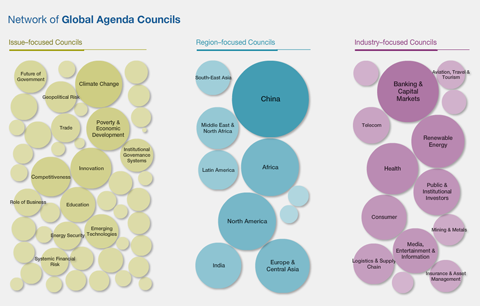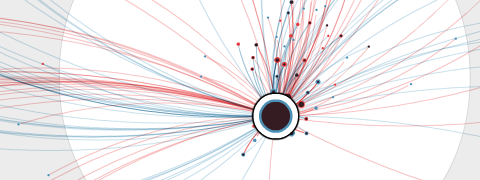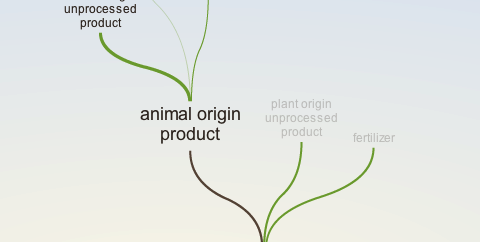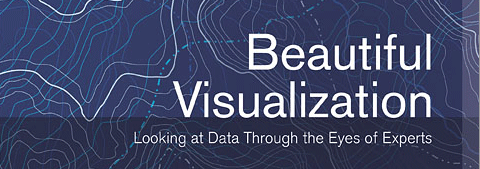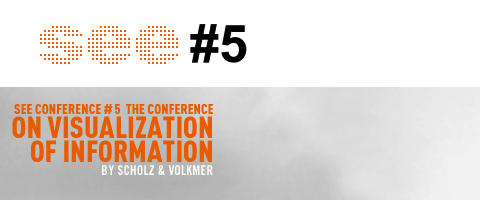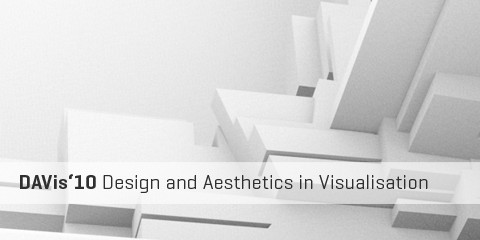Visualizations for the Global Agenda
Just a quick post to announce two visualizations which went live this week, related to the Global Agenda Summit of the World Economic Forum.
Global Agenda Outlook 2011
A half-explanatory, half-exploratory sequence of visualizations, summarizing the results of a survey among Global Agenda Council members about their perceptions of important trends and developments. This “guided” visualization can be quite satisfying, when done right (the New York Times graphics department are clearly masters in that genre), but poses some challenges, both from a technical as well as a conceptual point of view. Overall, I am quite happy with how it turned out and hope I will learn more about this type of mixed exploration/explanation tools.
GAC Issue Browser 2010
This application allows to browse and search for the Global Agenda Councils, based on their interlinkage. (Again, this data is based on a survey, where Council members were asked who their council should cooperate with).
On the start screen, the bubbles representing councils are scaled according to how much interest they received from other Councils. China is huge in this respect.
Clicking one of the bubbles will lead you to the detail screen, where you can see the exact interlinkage, and read the survey members’ commentary by hovering over the arrows.
Also noteable: There was a visualizing.org challenge based on the same data, so make sure to check out the results.
misc. updates
After a two month break – our second, and very lovely baby arrived – I am sort of back at the desk, so here are some news and my current plans to get everyone up to speed.
I am much looking forward to speaking at decoded conference October 23 in Munich, along with Mario Klingemann, Massimo Manzi, the Generatives Design book team and many others. Thanks already for envis precisely and reppa.net for organizing the event, I am sure it is going to be a great little conference. I think it is wise to get your tickets now, as the first early bird batch has sold out rather quickly…
Also, I will be teaching smaller workshops at TU Dresden and HfG Schwäbisch Gmünd in late November.
As a little diversion, and because I found the data set quite interesting, I made a little visualization of WNYC’s Map your moves dataset.
A little tree navigation I did for the organic edunet portal.
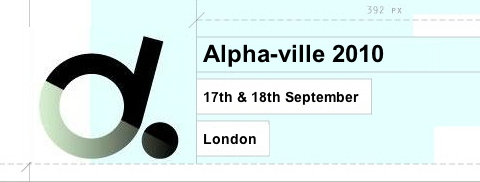
Update: revisit will be on display at the alphaville festival in London later this month.
Generally, I am really behind on documenting projects (Skype, dpa, …), but I hope I can catch in the next few weeks. One reason is that I would love to unify my two sites into one smart wordpress portfolio system, but this will take a while… Anyways, good to be back and see you around! Did I miss anything? ;)
Propositional density in visualization
A couple of months ago, I came across a very insightful article with high relevance for information visualization: “More with less” in the always excellent ACM interactions. It made me think quite a bit, and might also help some to understand a designer’s approach to visualization a bit better, so here is the gist of the story (the following section mostly paraphrases the original article).
Elastic Lists, revisit: open source!

In the past, I have profited immensely from using open source projects, foremost flare, but also many other libraries. I would like to give something back by open sourcing my favorite toy, the Elastic Lists project on github: github.com/MoritzStefaner/Elastic-Lists.
Have fun with it! Please keep in mind I am not a developer by training and these are side projects. Especially excuse the sketchy documentation. So if you start working with the code, and run into issues, feel free to file bug reports or add questions to the FAQ.
Heck, and while I am at it, why not publish revisit as well:
github.com/MoritzStefaner/revisit
Beautiful Visualization: The book
“Beautiful Visualization – Looking at data through the eyes of experts” is out (at least the ebook edition). I am proud to be among the authors, along with giants like Aaron Koblin, Fernanda Viega and Martin Wattenberg, Jer Thorp or Jessica Hagy. I mostly flipped through the book up to now, but from what I can see, it comprises a great collection of case studies and reflections by practitioners from the field. So if you always wondered about the stories and considerations behind great visualizations, this could be a very useful resource. My chapter deals with the process behind X by Y, and is available as a pre-print download (2.3MB pdf). I would love to see this book printed, too – if you feel the same, why not pre-order the print edition to speed up the process?
Also noteworthy: All royalties from this book will be donated to Architecture for Humanity.
revisit: real time twitter visualization
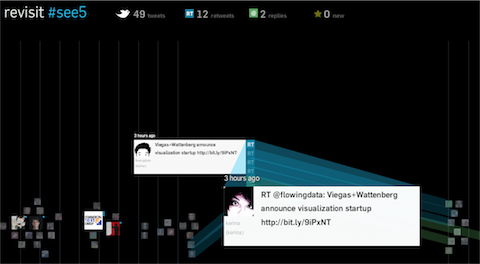
Just a quick post to let you know that I put a new project online: revisit – a real–time visualization of the last few hundred tweets around a topic. In contrast to the usual twitter walls, it try to capture some of the temporal dynamics as well as the conversational aspects of twitter. Scroll down for customization options!
Hope you like it – it will be at display at the see conference tomorrow, but for those of you who are not there, here is the live version so you can see what you are missing :)
see #5
In its five years of existence, the see conference managed to bring quite a few of the most exciting speakers from design, art, architecture and new technologies on stage to talk about their perspective on information visualization.
This year’s conference takes place on April 17, 2010 at the Kulturzentrum Schlachthof Wiesbaden (Germany) and features the following line-up:
- Gideon Obarzanek, the founder of Chunky Move, an Australian dance company known for “genre-defying dance performance”
- Joshua Prince-Ramus, President of REX, a cutting-edge architecture firm
- Nicholas Felton (feltron.com), a New York based information designer, co-founder of daytum.com and probably best known for his personal annual reports
- Hannes Koch from rAndom International, a London-based art and design collective
- Kent Demaine from OOOii, who design future interfaces for Hollywood and, among others, brought us the visionary interface design for Minority Report
- and amystery keynote speaker. (I love mysteries!)
Some tickets are still left, but not terribly many, so better register sooner than later. For those of you who cannot make it, there will be a live video stream of the event, and archived video recordings later. The recorded talks of the past conferences are well worth a visit too, with speakers ranging from Casey Reas over Carsten Nicolai to Stamen’s Eric Rodenbeck, Ben Fry, Zachary Lieberman and many more.
Presentation at TU Dresden
Last week, I gave a little presentation at the colloquium of the media informatics faculty at TU Dresden. Find the slides here. I would also like to use the chance to make you aware of the OUTPUT event on April 23, where student and research works are presented and some interesting talks are planned. For readers of this blog, probably the Technische Visualistik track will be most interesting, with talks about multi-touch, blended interaction, touchless interaction etc.
DaVis’10: Design and Aesthetics in Visualization
Everybody complains that art, design and research in information visualization should be talking more to each other.
Here is a unique opportunity: Andrew Vande Moere and I will be hosting a symposium at IV10: DAVis, the 5th International Symposium on Design and Aesthetics in Visualisation.
From the call:
“This symposium aims to bring together researchers and practitioners of design, art and related disciplines. The goal is to share their stories and experiences on how the needs and goals of both users and businesses are met through information visualisation.
It supports the publication of research in two general domains: Design and Aesthetics. Design refers to the development of visualisation as a creative design process. Aesthetics refers to the role of user experience in visualisation, as understood in three distinct components: aesthetic experience, experience of meaning, and emotional experience.
This symposium presents an opportunity to explore these issues and their consequences for the field of information visualization. In particular, we encourage the submission of design critiques; case studies, possibly with accompanying evaluation studies or critical reflections; position papers; or reports on the impact that visualization research or visualization use has had on the work and life of people. In this context, the story of failures or abandoned approaches can be as informative as descriptions of success. The fields of application are open, and can reach from traditional screen-based graphs, over innovative multi-touch interfaces, to dynamic media architecture displays.”
So – designers, coders, artists, visualizers – go forth and write!
Update: make sure to check out the submission requirements and procedure up at the IV main page.
Beware: the deadline is tight: March 1. March 21 But honestly, you would not have started earlier, anyways – right? Feel free to get in touch if you have any questions, and we are really looking forward to your submissions.
Generative Gestaltung
Generative Gestaltung is a unique new book on generative design (and related disciplines like visualization). It is quite example–driven, with loads of typical techniques explored in short processing sketches. At the moment it is only available in German, but I hear an English version is in the works. The website features all code examples and some community functions. Very nice concept and execution overall, and it really makes me eager on learning processing better :)
